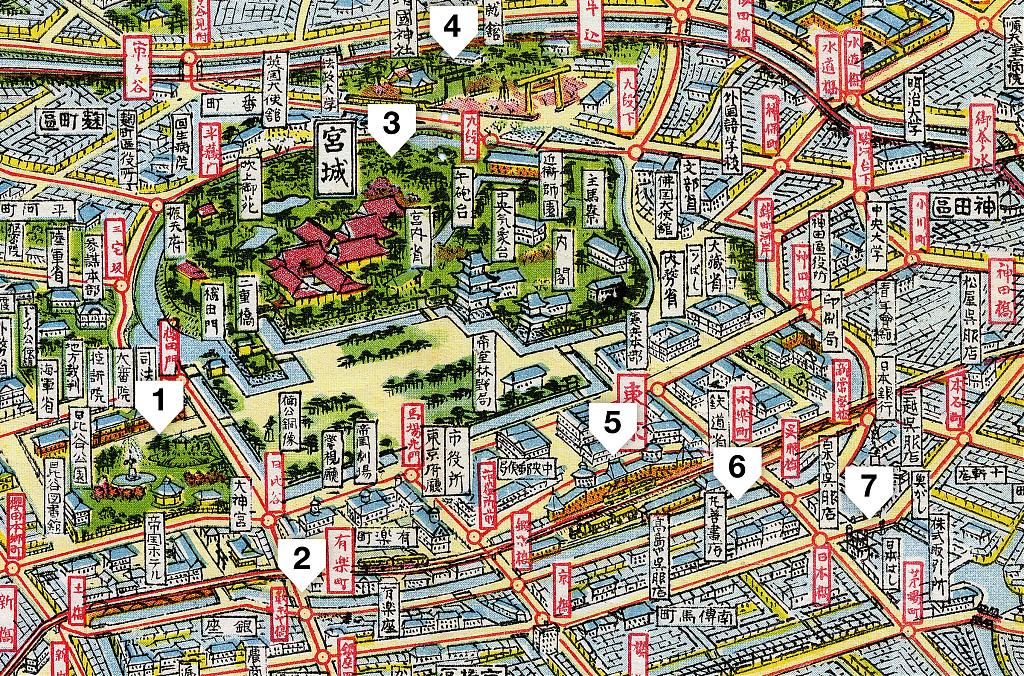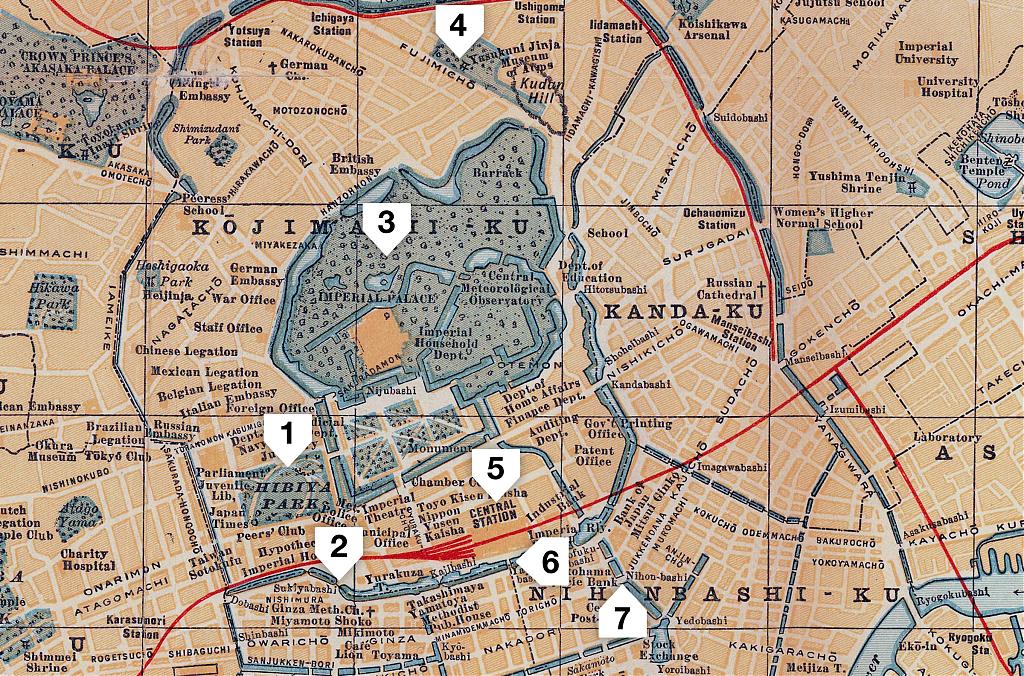Located in the Marunouchi business district of Tokyo, near the Imperial Palace grounds and the Ginza commercial district, Tokyo Station was designed by architect Tatsuno Kingo to celebrate Japan’s victory in the Russo-Japanese War.
Although Tokyo Station is now Japan’s most important train station, it was built almost half a century after Japan’s first railway tracks were laid.
Japan’s first daily train services started on June 12, 1872 (Meiji 5) between Shinagawa and Yokohama. Because the military would not allow tracks on their land, it would take until October of the same year before the tracks were extended to Shinbashi (also: Shimbashi) Station. On October 14, 1872 the line was officially opened by Emperor Meiji.1
In 1889 (Meiji 22), a plan for an elevated railway line connecting the Tokaido Main Line terminal at Shinbashi to the Nippon Railway (now Tohoku Main Line) terminal at Ueno was drawn up by a Tokyo municipal committee. In 1896 (Meiji 29), the Imperial Diet decided to construct a Central Station on this line.
The First Sino-Japanese War (1894–1895) and Russo-Japanese War (1904–1905) delayed the construction of the new station, but it was finally started in 1908 (Meiji 41). Tokyo Station was completed on December 18, 1914 (Taisho 3), and officially opened on the 20th.






Initially, the station had gates on the Marunouchi side only. The north side was the Station’s exit and the south side the entrance. Prime Minister Takashi Hara was assassinated by railway switchman Konichi Nakaoka at these south gates in the evening of November 4, 1921 (Taisho 10).
Hara was the leader of the Seiyukai (Association of Friends of Constitutional Government) and organized Japan’s first “true party based cabinet.” He intended to board the 7:30 p.m. sleeper to Kyoto to attend the Seiyukai’s Kinki Conference when the switchman, upset by Seiyukai policies, stabbed him to death.2
It was the first assassination since Japan had set up a constitutional government and it shocked the country. His successor Korekiyo Takahashi would lead a new Seiyukai Cabinet, but it soon fell. As part of efforts to create a single-party state, Seiyukai dissolved itself into the Imperial Rule Assistance Association in 1940.3
During the fire-bombings on May 25 and June 25, 1945 (Showa 20), the beautiful domes and the top floor were destroyed.4 After the end of the war in 1945, the station was quickly rebuilt. But instead of the elegant domes, simple angular roofs were built. There was no money to rebuild the third floor.

After the rebuilt Yaesu side was damaged by fire in 1949 (Showa 24), it received a contemporary exterior. At the same time, Daimaru department store was also added. The new facilities opened in 1953 (Showa 28) and were used for the Shinkansen (Bullet Train) when services began in 1964 (Showa 39).
On May 30, 2007 (Heisei 19) a ground-breaking ceremony was held for the restoration of the Marunouchi side of Tokyo Station. It was restored to its original design, with the surrounding area becoming a broad plaza. The station was also made more earthquake proof. The overall project cost was estimated at approximately 50 billion yen (469 million dollars at the time) and took until 2012.5




Many sources claim that the station was inspired by Amsterdam’s Central Station, but architectural historian Terunobu Fujimori believes that this is not the case.6
Tokyo Station is Tokyo’s main intercity rail terminal and the busiest station in Japan in terms of number of trains per day.7 It is the third-busiest in Japan in terms of boarding passengers. Tokyo’s Shinjuku station is number one.8
Tokyo Station has been designated an Important National Cultural Asset.


| JAPANESE RAILWAYS TIMELINE |
|
|---|---|
| 1854 | Commodore Matthew Perry introduces a model of a steam locomotive to Japan. |
| 1865 | A demonstration of a steam locomotive is given in Nagasaki. |
| 1872 | Opening of Japan's first railway between Shinbashi (Tokyo) and Yokohama. |
| 1874 | The first return tickets are sold in Japan for the railway connection between Osaka and Kobe, started this year. |
| 1881 | Foundation of Nippon Railway, Japan's first private railway company. |
| 1882 | Opening of Horonai Railway, first railway in Hokkaido. |
| 1888 | Opening of Iyo Railway, first railway in Shikoku. |
| 1889 | Opening of Kyushu Railway, first railway in Kyushu. Completion of the Tokaido Main Line |
| 1893 | Class 860 steam locomotive, first locomotive built in Japan. |
| 1895 | Opening of Japan's first streetcar in Kyoto. Japan's acquisition of railway in Taiwan. |
| 1899 | Opening of Keijin Railway, first railway in Korea. |
| 1906 | Opening of first railway in Karafuto. Foundation of South Manchuria Railway. Nationalization of 17 private railways (through 1907). |
| 1914 | Opening of Tokyo Station. |
| 1925 | Inauguration of the Yamanote Loop Line. |
| 1927 | Opening of Tokyo subway, the first subway in Asia. |
Notes
Additional reading: Aoki, Eiichi (2000). A history of Japanese railways 1872–1999. 東日本鉄道文化財団.
1 Aoki, Eiichi (1994) Japanese Railway History: Dawn of Japanese National Railways. Japan Railway & Transport Review / March 1994: 28–30. Retrieved on 2023-09-25.
2 National Diet Library. Taisho Democracy, The Era of Party based Government, 3-10 Assassination of Prime Minister HARA. Retrieved on 2023-09-25.
3 Wikipedia, Rikken Seiyūkai. Retrieved on 2023-09-25.
4 Wikipedia, Tokyo Station. Retrieved on 2023-09-25.
5 East Japan Railway Company, Press release: Commencement of Preservation and Restoration Work on the Tokyo Station Marunouchi Building. Retrieved on 2008-02-03.
6 Fujimori, Terunobu (1997). 建築探偵 雨天決行. Asahi Shimbunsha. ISBN 9784022611796.
7 Ito, Masami (December 13, 2014). Tokyo Station at 100: All change. The Japan Times. Retrieved on 2023-09-25.
8 East Japan Railway Company. 各駅の乗車人員. Retrieved on 2023-09-25.
Published
Updated
Reader Supported
Old Photos of Japan aims to be your personal museum for Japan's visual heritage and to bring the experiences of everyday life in old Japan to you.
To enhance our understanding of Japanese culture and society I track down, acquire, archive, and research images of everyday life, and give them context.
I share what I have found for free on this site, without ads or selling your data.
Your support helps me to continue doing so, and ensures that this exceptional visual heritage will not be lost and forgotten.
Thank you,
Kjeld Duits
Reference for Citations
Duits, Kjeld (). Tokyo 1920s: Tokyo Station, OLD PHOTOS of JAPAN. Retrieved on December 12, 2025 (GMT) from https://www.oldphotosjapan.com/photos/17/tokyo-1920s-tokyo-station




Matthew Hall
Thank you for this historical write up and the great picture in the top! I just love this hotel and read / study whatever I can about it and its history. I would love to find some architectural drawings / elevation drawings of this beautiful building.
#000743 ·
Kjeld (Author)
@Matthew Hall: Thank you, Matthew. I seem to recall I have seen elevation drawings. Unfortunately none in my collection yet. I will keep my eyes open!
#000744 ·